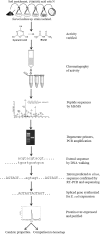Expanding the cyanuric acid hydrolase protein family to the fungal kingdom
- PMID: 24039269
- PMCID: PMC3837953
- DOI: 10.1128/JB.00965-13
Expanding the cyanuric acid hydrolase protein family to the fungal kingdom
Abstract
The known enzymes that open the s-triazine ring, the cyanuric acid hydrolases, have been confined almost exclusively to the kingdom Bacteria and are all homologous members of the rare cyanuric acid hydrolase/barbiturase protein family. In the present study, a filamentous fungus, Sarocladium sp. strain CA, was isolated from soil by enrichment culturing using cyanuric acid as the sole source of nitrogen. A reverse-genetic approach identified a fungal cyanuric acid hydrolase gene composed of two exons and one intron. The translated spliced sequence was 39 to 53% identical to previously characterized bacterial cyanuric acid hydrolases. The sequence was used to generate a gene optimized for expression in Escherichia coli and encoding an N-terminally histidine-tagged protein. The protein was purified by nickel affinity and anion-exchange chromatography. The purified protein was shown by (13)C nuclear magnetic resonance ((13)C-NMR) to produce carboxybiuret as the product, which spontaneously decarboxylated to yield biuret and carbon dioxide. The protein was very narrow in substrate specificity, showing activity only with cyanuric acid and N-methyl cyanuric acid. Barbituric acid was an inhibitor of enzyme activity. Sequence analysis identified genes with introns in other fungi from the Ascomycota that, if spliced, are predicted to encode proteins with cyanuric acid hydrolase activity. The Ascomycota cyanuric acid hydrolase homologs are most closely related to cyanuric acid hydrolases from Actinobacteria.
Figures






References
-
- Wöhler F. 1829. On the decomposition of urea and uric acid at high temperature. Ann. Phys. Chem. 15:619–630
-
- Puschner B, Poppenga R, Lowenstine L, Filigenzi M, Pesavento P. 2007. Assessment of melamine and cyanuric acid toxicity in cats. J. Vet. Diagn. Invest. 19:616–624 - PubMed
-
- Seto CT, Whitesides GM. 1990. Self-assembly based on the cyanuric acid-melamine lattice. J. Am. Chem. Soc. 112:6409–6411
-
- Brown CA, Jeong KS, Poppenga RH, Puschner B, Miller DM, Ellis AE, Kang K-I, Sum S, Cistola AM, Brown SA. 2007. Outbreaks of renal failure associated with melamine and cyanuric acid in dogs and cats in 2004 and 2007. J. Vet. Diagn. Invest. 19:525–531 - PubMed
Publication types
MeSH terms
Substances
LinkOut - more resources
Full Text Sources
Other Literature Sources
Molecular Biology Databases

